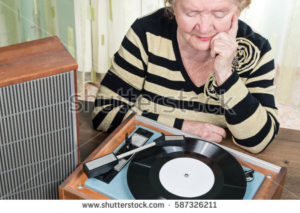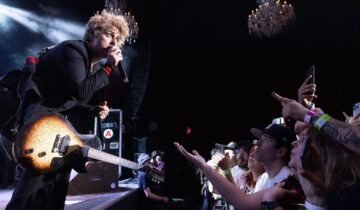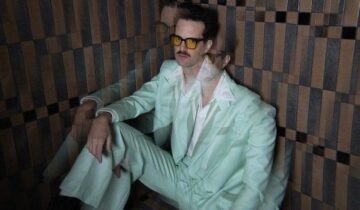 For the ECONOMIST: In one scene of “Alive Inside” (2014), a documentary film, a member of nursing-home staff offers headphones to a wheelchair-bound man named Henry. He had been unresponsive and hunched over, but as Cab Calloway plays, he sits up, opens his eyes wide and begins singing and moving his arms and hands. The music was triggering memories for Henry; family members say he had always been a huge fan of jazz and blues. A shorter version of the film is available on YouTube, and has been viewed more than 2m times to date.
For the ECONOMIST: In one scene of “Alive Inside” (2014), a documentary film, a member of nursing-home staff offers headphones to a wheelchair-bound man named Henry. He had been unresponsive and hunched over, but as Cab Calloway plays, he sits up, opens his eyes wide and begins singing and moving his arms and hands. The music was triggering memories for Henry; family members say he had always been a huge fan of jazz and blues. A shorter version of the film is available on YouTube, and has been viewed more than 2m times to date.
There has been much research on music’s effect on those with progressive disorders like Parkinson’s, where it can help to regulate gait and involuntary body movements, and Alzheimer’s, where music has been found to stimulate positive interactions and help people recall memories. Verbal memory improves among stroke patients who listen to music. For recovering opioid addicts, music listening can lower blood pressure and raise the patient’s pain threshold, often meaning that they require less pain medication. Streaming services now offer range and affordability to healthcare professionals keen to include music in treatment.
There are about 7,000 specialist therapists working with music in America, about 2,000 of them working specifically with elderly people. But their scope is limited. They work with roughly 30 people one-to-one a week, according to Dan Cohen, the founder of Music & Memory, a non-profit. His company instead trains nursing home staff, elder-care workers and family members to create personalised song playlists for patients (Mr Cohen appears in “Alive Inside”). “It’s not just about saying ‘Mom likes jazz,’ but which jazz artist does she like the most, which songs might trigger memories for her?” Mr Cohen says.
A benefit of the scheme is that it is cheap to run. Subscriptions to services like Apple Music or Spotify run at $10-15 per month, and songs downloaded from iTunes are usually $0.99. (“We can take the Frank Sinatra song ‘New York, New York’ for example, and legally we can sync that song onto 500 iPods for our patients,” Mr Cohen says.) Tracks uploaded from old CDs—which are often donated to Music & Memory—cost nothing. He estimates that making playlists costs about $80 a year per patient, or about $6 per month per person. Music & Memory solicits about 300 donated iPods per month, and many nursing homes receive government money to implement music for therapeutic purposes. “This is the least expensive program for improving life that there is,” he says.
Dedicated software is emerging to make the job of creating personalised playlists simpler for health care professionals. MusicLink, a new music licensing portal, now offers 20m songs for this purpose. After the carer selects basic categories of “mood” and “timbre”, an algorithm will take a “seed track” and suggest similar tunes. Through a combination of algorithm and individually chosen songs, playlists are personalised. Parkinson’s patients, to take one example, can receive playlists of a particular number of beats per minute.
Some health-care organisations are putting music at the heart of their services. Recovery Unplugged, which specialises in addiction recovery, offers musical assessments of prospective patients alongside financial and clinical ones. Staff might ask what the patient’s preferred genre is, or a favourite artist. Through a large database of songs from donated CDs, digital subscriptions and original music created for their facilities, they specialise playlists before the new patient arrives.
“Maybe ‘Little Dreamer’ from Van Halen reminds you of your first girlfriend or your parents, so when I pick you up, that song is playing in the van. Right away rapport is established, and you feel heard,” says Paul Pellinger, Recovery Unplugged’s chief strategy officer. “Our adjustment period is quicker because of this. Some clients have difficulty sharing their emotions, but I guarantee someone has written a song about it.” Mr Pellinger, an addictions clinician and counsellor, thinks music is a universal method of treatment. Whether it’s a lyric, a melody or just vibrations, he argues that music is able to bring about profound personal change.
Therapeutic music programs can be significantly aided by proactive family and friends, who can collaborate on playlists while loved ones are still in good health. Mr Cohen gave his father a playlist when his health was fine, and incorporated it into the recovery process when his father suffered an unexpected heart attack. Some pilot programs in America are matching high-school students with nursing programs so that tech-savvy teens can speak with family members, sit down one-to-one with patients, and manage the technological side of creating playlists. More than 20 American states have adopted music into their health care policies. It seems there is plenty more that can be done.
Image: courtesy of Shutterstock



